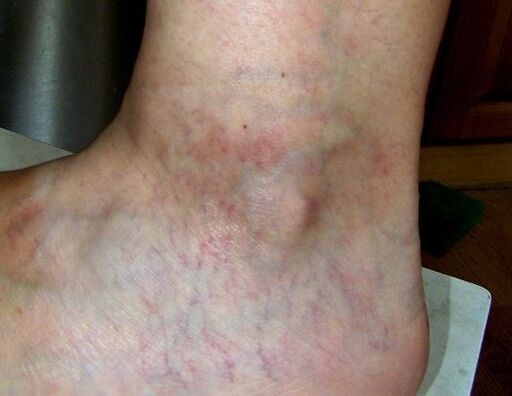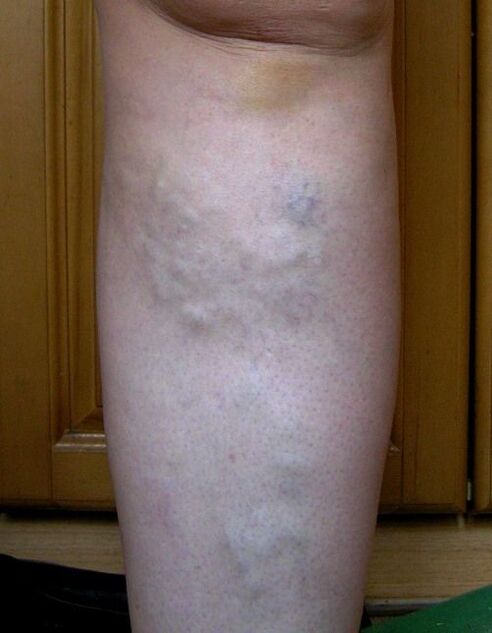
Today we will talk about varicose veins of the legs, varicose veins of the lower extremities – a very common vascular pathology, causes, symptoms, disease prevention, therapeutic exercises with a set of exercises.
Varicose veins (varicose veins) – what kind of disease is it, photo
Phlebeurysm(see photo of the manifestations of varicose veins on the legs) is the scourge of our time; While very old people used to be affected by this progressive disease with circulatory problems and valve weakness, today the first signs of this disease of the peripheral vessels appear in twenty-year-olds.
Spider veins (telangiectasia) appear first. Then the superficial veins become less elastic, twist, become visible and protrude beyond the skin of the leg and thigh. The blood flows more slowly and has difficulty rising. There is venous stagnation and swelling, which disappears after a night's rest. There is a risk of blood clots forming.
And during pregnancy and childbirth, when the level of female hormones that weaken the vascular wall increases rapidly, every third woman is diagnosed with this pathology of the veins of the lower extremities.
But not only the limbs, even at the age of 30-35, varicose veins of the pelvic organs (which begin to develop due to fluctuations in intravascular pressure during contractions), hemorrhoids and varicoceles (enlargement of the spermatic cord veins in men) appear en masse.
There are varicose veins of the esophagus and stomach.
Varicose veins - ICD-10 code
The ICD-10 (International Classification of Diseases) code for this disease is 183
- When varicose veins are complicated by an ulcer – 183. 0
- For varicose veins with inflammation, stagnant dermatitis - 183. 1
- When the first two conditions are combined – 183, 2
- When varicose veins are uncomplicated – 183, 9
Symptoms of varicose veins of the lower extremities
Nodules, swollen veins in the legs, a blue network of small vessels, spider veins, swelling in the evening, excruciating, aching pain along the veins, burning, sometimes itching, feeling of heaviness in the legs at the end of the day, the appearance of night cramps, paresthesias -Goosebumps and numbness.
And as the disease progresses significantly, the following often occurs:
- Thrombophlebitis (which is manifested by the appearance of sharp pain along the vein, redness, local increase in temperature, swelling, sometimes you can feel painful areas with a blood clot blocking the lumen of the vessel, in severe cases chills begin, a transition from the inflammatory processfrom superficial to deep veins is observed),
- trophic ulcers against the background of chronic venous insufficiency.
Probably no one will like this picture. And then there is the risk of a blood clot detaching and a stroke or heart attack, tissue necrosis. . . But that's pretty sad.
Since it is not evolutionarily acceptable for us to return to walking on all fours to relieve the strain on the veins, we must look for methods to naturally relieve the strain on our legs.
Causes of varicose veins and predisposing factors
- Genetics (inheritance).
- Changes in hormone levels (pregnancy, hormonal contraceptives).
- Strong physical activity, especially static, standing or sitting activities.
- Overweight.
- Chronic cough.
- Smoke.
- Leg injuries that damage the valves in the blood vessels.
Women successfully provoke the development of varicose veins by standing and walking for long periods in high heels and sitting cross-legged at a table.
Wearing thongs and tight synthetic underwear has an unfavorable effect.
Which doctor treats varicose veins of the legs?
A phlebologist deals with veins. If surgical intervention is already required – a vascular surgeon.

Diagnosis of varicose veins
To make a diagnosis, in addition to an external examination of the lower extremities and taking anamnesis (complaints), the following measures are carried out:
- Doppler ultrasound (determines the quality, speed of blood flow, the presence of obstacles in the form of blood clots, blood clots),
- Transillumination (transillumination of veins, even with changes that are not yet visible to the eye).
In addition, the diagnosis of varicose veins is not complete without taking a blood sample for coagulation.
Modern medicine does not provide an effective way to treat this disease; radical removal of superficial veins does not count. There are also radiofrequency ablation, laser therapy and sclerotherapy, but they are not suitable for everyone, there are contraindications and they are indicated mainly in the early stages of this disease.
But what can we do if we have varicose veins at home to counteract this unpleasant vascular disease?
Therapeutic exercises for varicose veins on the legs
The prevention of varicose veins primarily involves gymnastic exercises, which is not surprising, since the vessels simply need to be trained.
The most advantageous functional position of the legs with varicose veins is elevated, elevated. However, it is not possible to spend all the time with the legs in the air, and stagnation of the venous network must be somehow avoided, as this leads to heaviness in the legs, cramps and swelling.
And it turns out that it is more useful for a person to walk and even run than to sit for hours in the office or in front of a computer; When at rest, there is practically no movement of blood, the fluid enters the body's tissues and the swelling increases.
That's why we don't let off steam at work, often take breaks during work, get up, stretch, walk around the table, go to the toilet if possible, climb a few stairs and do a few exercises.
Such a warm-up and distraction from sedentary activity is also useful for diseases of the eyes and spine (the neck and lower back are most affected).
A set of exercises for varicose veins
- We sit on a chair so that our feet do not touch the floor. We turn our legs at the ankles, bend and straighten them to a strong tension, then we do the same with our toes, each exercise 15-20 times. A foot massage is also useful if you have varicose veins on your legs.
- Walk vigorously in place for a minute.
- We stand close to the wall, palms at shoulder level, the center of gravity is on the wall. We stand on tiptoes and fall on our heels, 10-15 such rolls.
- Slowly stand on tiptoes, feet shoulder-width apart, arms up.
- "Bike" with your feet from the supine position.
- "Scissors" (cross strong stretched legs like scissors).
- Slowly swing your legs from a side position, alternating with the right and then with the left.
- Pull your knees up to your chest. Repeat 20 times.
In addition to therapeutic exercises, sports activities are extremely useful for diseases of the veins of the lower extremities - swimming, water aerobics (in water the pressure on the veins is reduced twice! ), skiing, cycling, running.
It should also be borne in mind that some exercises can only harm the veins - strength training with a barbell, jumping rope, long and intensive running and long training on the exercise bike are contraindicated. Team sports with jumping and running – football, basketball, volleyball (the valve system is injured) are not recommended if the blood vessels in the legs are weak.
Prevention of varicose veins at home
How can you prevent varicose veins on your legs?
- In addition to exercises, contrast showers and compression stockings for the blood vessels are very useful.
The latter has its disadvantages: firstly, it is quite expensive and secondly, after wearing it for a long time, the vessels become completely soft and no longer function independently.
Therefore, I would not recommend it for long-term use, but rather for heavy loads, standing work, long hikes and during pregnancy.
- It is useful to strain the legs by climbing stairs, vibration gymnastics or jumping (quickly standing on tiptoes and lightly placing the heels on the floor two to three times a day, 30-60 times, while lifting the heels deeply). 1-2cm).
- You should not abuse prolonged exposure to the sun, in a bathhouse or in hot baths.
- Drink at least 2 liters of fluid per day, it is advisable to control your weight and make sure that the vegetable-vegetable portion predominates in your diet. You should avoid alcohol and spicy, smoked and salty foods or at least greatly reduce their proportion in your diet.
- No tight underwear, shoes, socks or socks with a tight elastic band.
- Avoid drinking champagne during the holidays as it can tend to make your illness worse.
- Don't wear high heels every day. Over 4 cm - already big.
- Don't squat.
- Do not cross your legs; In this position, the vessels are pinched and the already poor flow of blood from the extremities becomes even more difficult.
- Try not to stand still, even in line; it is better to switch from one foot to the other.
- Remember that vitamin C maintains the elasticity of the vascular wall.

























